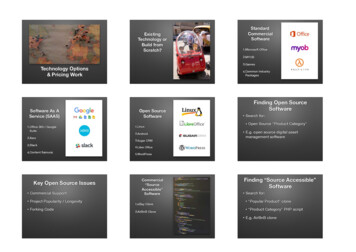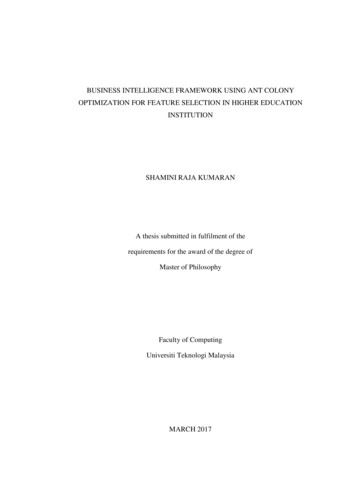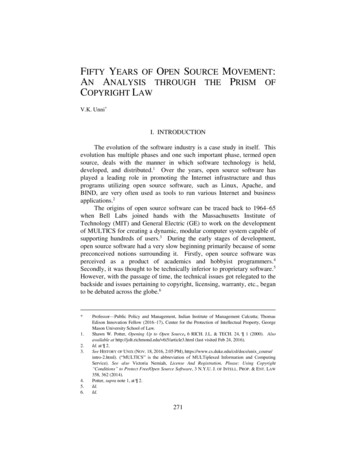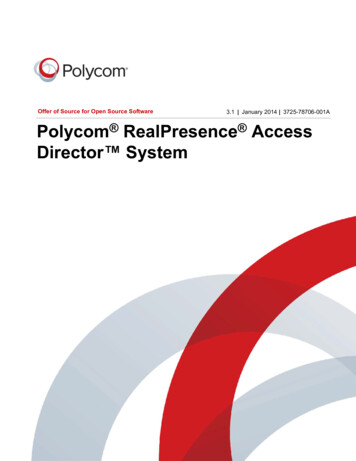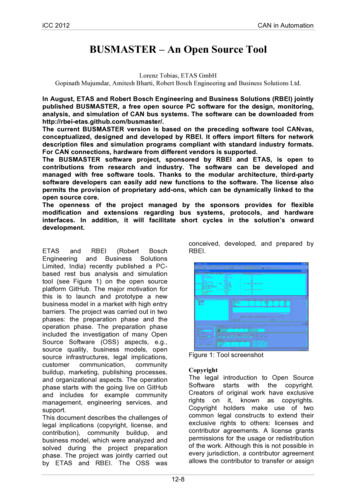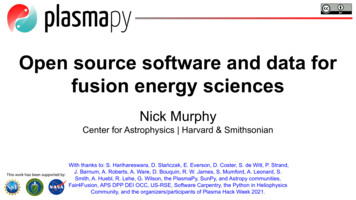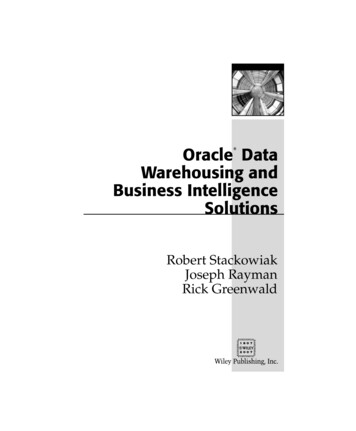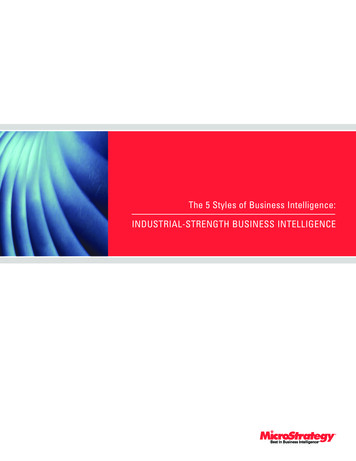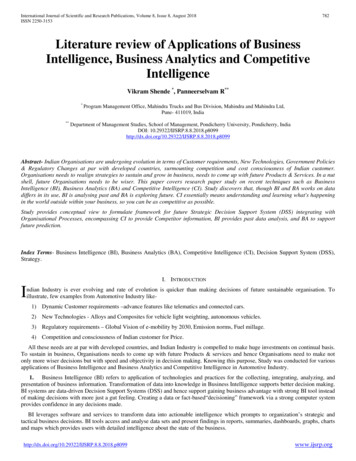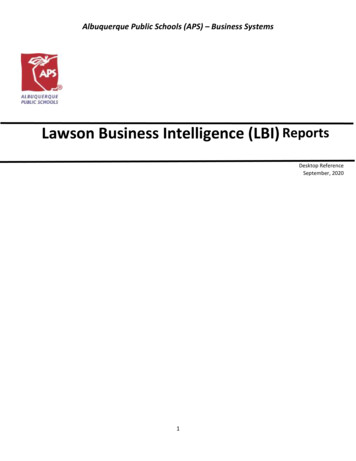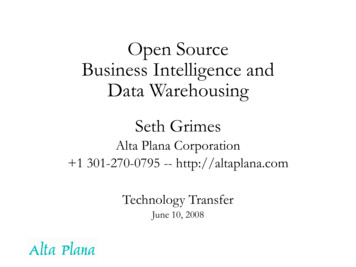
Transcription
Open SourceBusiness Intelligence andData WarehousingSeth GrimesAlta Plana Corporation 1 301-270-0795 -- http://altaplana.comTechnology TransferJune 10, 2008
Open Source BI and Data WarehousingCourse goals and approach2The goal is that you understand:Open source business & technology.Open source BI & DW options.How to evaluate and implement.Approach:There are many aspects of open source. I will try tobe comprehensive and complete.I will maintain a practical focus.I provide a lot of reference material that I will notcover extensively.Copyright 2008 Alta Plana CorporationTechnology Transfer
Open Source BI and Data WarehousingCourse goals and approach3Myself, I regularly use open-source software:Apache, MySQL, Python since the mid/late-‘90s.Firefox, Thunderbird, OpenOffice, GIMP, etc.I occasionally use R, GATE, cygwin, TrueCrypt.On a project: Mondrian, JPivot.Copyright 2008 Alta Plana CorporationTechnology Transfer
Open Source BI and Data WarehousingCourse goals and approach4I believe in open source as a philosophycentering on collaboration and sharing.I see open source as a viable approach tosoftware publishing.Seth GrimesI think that open-source products, if properlychosen and used, are reliable, performant, andsafe.Copyright 2008 Alta Plana CorporationTechnology Transfer
Open Source BI and Data WarehousingPerspectives5You are:1. A BI end user or manager.2. IT staff or management, responsible forsupporting BI/DW in your organization.Seth Grimes3. A software developercreating BI applications orproducts.4. Someone who develops or works with opensource, and you want to learn about BI/DW.5. Other?This class will address the needs of all roles.Copyright 2008 Alta Plana CorporationTechnology Transfer
Open Source BI and Data WarehousingCourse sections6The Business of Open SourceThe business case for open source.History, developments, and trends.Licensing and support.Open Source Technology and SolutionsInfrastructure, applications, databases, and tools.BI, data warehousing, and integration.Evaluating and implementingBest Practices, strategy, and resources.Copyright 2008 Alta Plana CorporationTechnology Transfer
Open Source BI and Data WarehousingThe Cathedral & the BazaarCopyright 2008 Alta Plana Corporation7Technology Transfer
Open Source BI and Data WarehousingThe Cathedral & the Bazaar8―I believed that the most important software(operating systems and really large tools likeEmacs) needed to be built like cathedrals,carefully crafted by individual wizards or smallbands of mages working in splendid isolation,with no beta to be released before its time.―Linus Torvalds's style of development - releaseearly and often, delegate everything you can, beopen to the point of promiscuity - came as asurprise. No quiet, reverent cathedral-buildinghere - rather, the Linux community seemed toresemble a great babbling bazaar of differingagendas and approaches (aptly symbolized bythe Linux archive sites, who'd take submissionsfrom anyone) out of which a coherent and stablesystem could seemingly emerge only by asuccession of miracles.―The fact that this bazaar style seemed to work,and work well, came as a distinct shock.‖Copyright 2008 Alta Plana CorporationTechnology Transfer
Open Source BI and Data WarehousingAgenda9The Business Case for Open SourceLicensing and supportInfrastructure, applications, databases, and toolsBI, data warehousing, and data integrationEvaluation and implementation best practices,strategy, and resourcesCopyright 2008 Alta Plana CorporationTechnology Transfer
Open Source BI and Data WarehousingOrigins of Open Source10First Thesis:Open Source is as old as computing.Modern computing originated in the WW II era.New electronics, e.g., radar.Need to support sophisticated logistics, artillerytrajectories, etc.Cryptography and code-breaking.Military-industry-university collaboration.Continues to this day, e.g., DARPA, In-Q-Tel.Copyright 2008 Alta Plana CorporationTechnology Transfer
Open Source BI and Data WarehousingOrigins of Open Source11Through the ‗60s, hardware vendors createdand/or supplied most systems software.Logic design, ―machine language‖ and assembler.Input/Output control.Batch/job control.Higher-level languages (Cobol, Fortran, Algol).Transaction management.Early database systems.Software was bundled and was essentially free.Copyright 2008 Alta Plana CorporationTechnology Transfer
Open Source BI and Data WarehousingOrigins of Open Source12The late ‗60s featured:ICs (integrated circuits) and lower costs.Commodity hardware with wider diffusion forbusiness and science (e.g., the space program).This led to independent software development,with a culture of openness and sharing, atuniversities and research centers.The real founding moment for open source was thecreation of Unix at Bell Labs.Commercialization changes the game.Copyright 2008 Alta Plana CorporationTechnology Transfer
Open Source BI and Data WarehousingOrigins of Open Source13Open source is cooperative in essence, reflectingacademic/research culture.Closed source is competitive in essence,reflecting commercial culture. but most of the software world is noteither/or.Copyright 2008 Alta Plana CorporationTechnology Transfer
Open Source BI and Data WarehousingOrigins of Open Source14Open source can be competitive in origins andintent and distribution.Motivations include desire for recognition andinfluence and profit from added value, e.g., servicesand up-sell.Open source developers are self-interested.Closed source can be open to Alliances.Interoperation.Copyright 2008 Alta Plana CorporationTechnology Transfer
Open Source BI and Data WarehousingWhat is open source?15What is open source? For software:Source code is free and easily available.You can modify source code for your own purposes.You do not necessarily get an executable ordocumentation.It may not compile or run on every platform.You are not necessarily allowed to distribute alertedcode.You may not be allowed to sell software that usesopen source assets.Copyright 2008 Alta Plana CorporationTechnology Transfer
Open Source BI and Data WarehousingWhat is open source?16Not open source?Certain customers can see the source code forMicrosoft Windows.Oracle owns InnoDB, a MySQL transactionalengine, and Berkeley DB.Open source?You must contribute any Linux kernel modificationsthat you distribute.Apache server may be used in commercial products.StarOffice is based on and extends OpenOffice.Copyright 2008 Alta Plana CorporationTechnology Transfer
Open Source BI and Data WarehousingStandards17Open source relies on standards.Windows API (application programming interface)and the .Net framework.SQL (Structured Query Language) and ODBC(open database connectivity).Java EE stack, e.g., JSR 168 portlet specification.UIMA (Unstructured Information ManagementArchitecture), an text analytics interoperabilityframework.Copyright 2008 Alta Plana CorporationTechnology Transfer
Open Source BI and Data WarehousingStandards18Open source relies on standards.Some standards are de-facto, market standards:Intel chip architectures and instruction sets.Windows API (application programming interface) andthe .Net framework.ODBC (open database connectivity).Some standards are open, community owned:* SPARC chip architectures and instruction sets.* SQL (Structured Query Language).JSR 168 portlet specification,* Java EE framework.* closed, proprietary originsCopyright 2008 Alta Plana CorporationTechnology Transfer
Open Source BI and Data WarehousingStandards19We have standards for:Hardware architecture.Operating systems.Software platform and applications stack.Programming tools.APIs and interoperability frameworks.Open-source may run on closed-sourcehardware and software platforms andinteroperate with closed-source software and vice versa.Copyright 2008 Alta Plana CorporationTechnology Transfer
Open Source BI and Data WarehousingStandards20Development of open standards must be open –OASIS (Organization for the Advancement ofStructured Information Standards) is a not-forprofit, international consortium that drives thedevelopment, convergence, and adoption of ebusiness standards.www.oasis-open.org/who/The Java Community Process (JCP) is themechanism by which the Java community developsstandard technical specifications for Javatechnology.jcp.org/en/home/indexCopyright 2008 Alta Plana CorporationTechnology Transfer
Open Source BI and Data WarehousingMore Open.21―Open‖ may also apply to or suggest:Algorithms and techniques.Processes.Information.Other intellectual property.Copyright 2008 Alta Plana CorporationTechnology Transfer
Open Source BI and Data WarehousingOpen knowledge22We have the Open Access Initiative.An ―international effort to make research articles inall academic fields freely available on the Internet.‖www.soros.org/openaccess/―Our mission of disseminating knowledge is onlyhalf complete if the information is not madewidely and readily available to society.‖Berlin Declaration, October 2003; www.ec-petition.eu/SPARC, the Scholarly Publishing and AcademicResources Coalition, is an international alliance ofacademic and research libraries that is backing this.www.sparceurope.org/Copyright 2008 Alta Plana CorporationTechnology Transfer
Open Source BI and Data WarehousingOpen designs23We have OpenSPARC (www.opensparc.net/).SPARC Scalable Processor ARchitecture., a RISCarchitecture that dates to the late ‘80s.Sun Microsystems, with SPARC, revolutionizedworkstation and network computing.Sun opened UltraSPARC T1 source code in 2006.Lets ―developers create innovative software applicationsfaster with a higher degree of hardware integration.‖―Helps create an environment that will speed thedevelopment of new, thread-rich applications.‖―Gives OEMs the opportunity to create unique solutionsbuilt on a proven architecture.‖Copyright 2008 Alta Plana CorporationTechnology Transfer
Open Source BI and Data WarehousingOpen IP24Intellectual property.W3C patent policy (2004) requires royalty-free useof patents that are relied on by 0205/IBM (January 2005) pledged open access to keyinnovations covered by 500 IBM software patentsfor use in open-source software.―While IP ownership is an essential driver of innovation,technological advances are often dependent on sharedknowledge, standards, and collaborative gedpatents.pdfCopyright 2008 Alta Plana CorporationTechnology Transfer
Open Source BI and Data WarehousingOpen IP25Intellectual property, continued.Sun Microsystems (January 2005) then released over1,600 patents to open source.Common Development and Distribution License.Includes the OpenSolaris operating system nflash.20050125.2.xmlOpen Invention Network created (2005).IBM, NEC, Novell, Philips Red Hat, Sony.www.openinventionnetwork.com/index.phpPatent commons initiative.Started by the OSDL, now the Linux Foundation.Copyright 2008 Alta Plana CorporationTechnology Transfer
Open Source BI and Data WarehousingThe Business Case26Second Thesis:You are already using open-source software and services.Why do people & organizations introduce OS?Everybody‘s using it, e.g., Apache Web server.Through a competitive evaluation, often against non-OS.Included in a distribution, that is, a packaging that includes avariety of software components.Unintentionally, not knowing it‘s OS.Platform-indicated choice, that is, it‘s the only option givenyour computing platform.IT mandate.Copyright 2008 Alta Plana CorporationTechnology Transfer
Open Source BI and Data Warehousing27The Road to Open Source Adoption―Technologyadoption typicallyfollows an SCurve, going fromfirst contact tocompleteinstitutionalization.‖ – SourceSenseIs this ht 2008 Alta Plana CorporationTechnology Transfer
Open Source BI and Data WarehousingThe Business Case28From the blog of Sun Microsystems CEO JonathanSchwartz, April 14, 2008 (http://blogs.sun.com/jonathan/):―A few weeks ago, I was visiting a large commercial institution We had just closedthe acquisition of MySQL, so before I wrapped up, I asked, "And would you like aquick update on the newest addition to our family, MySQL?‖―The CIO responded categorically with ‗we don't run MySQL, we run [name withheld toprotect the proprietary].‘ The CISO said, ‗We can't just let developers download softwareoff the net, you know, we've got regulation and security to worry about.‘ The CTOsmiled. Everyone else appeared to be sitting on their hands. I was going to leave it atthat. Thanks for the business.―Until a (diplomatically) assertive Sun sales rep piped up, ‗Um. no, I connected with abuddy of mine over at MySQL, and had him check - you've downloaded MySQL morethan 1,300 times in the last twelve months.‘―After a profoundly awkward silence, one of the individuals from their internaldevelopment team piped up, ‗Actually, everybody uses it. Why bother hassling withlicense agreements when MySQL's got you covered. We're stoked you bought them.‘‖Copyright 2008 Alta Plana CorporationTechnology Transfer
Open Source BI and Data WarehousingThe Business Case29Computer Economics surveyed visitors to itswebsite regarding the perceived advantages inthe use of open source software (May 2005).www.computereconomics.com/article.cfm?id 1043Copyright 2008 Alta Plana CorporationTechnology Transfer
Open Source BI and Data WarehousingEvaluation criteria30If evaluation, what criteria?1.2.3.4.5.6.7.8.Cost.Ease of ibility.Security.Ease of use.Quality and capabilities.Copyright 2008 Alta Plana CorporationTechnology Transfer
Open Source BI and Data WarehousingEvaluation criteria31Criterion 1, Cost:Software is free, that is, no licensing cost.Sometimes free, OS versions have limited capabilities orusage terms. More later.You must examine the Total Cost of Ownership(TCO), the cost of:Supporting hardware.User support and training.Software maintenance, community participation.Intellectual Property indemnification.Copyright 2008 Alta Plana CorporationTechnology Transfer
Open Source BI and Data WarehousingEvaluation criteria32Criterion 2, Ease of evaluation/introduction:You don‘t have to deal with vendor sales and theirinsistence on qualifying prospects.The vendor doesn‘t control the evaluation; they don‘tlimit its duration, data volume, functions used,number of users taking part.By actually installing the software for evaluation, youcan better assess the TCO.Copyright 2008 Alta Plana CorporationTechnology Transfer
Open Source BI and Data WarehousingEvaluation criteria33Criterion 3, Flexibility:You can modify the source code.You can use and install only those modules youneed.You can often incorporate the software incommercial products or services at no royaltycost.You can move the software among machines withoutlicense hassles.Copyright 2008 Alta Plana CorporationTechnology Transfer
Open Source BI and Data WarehousingEvaluation criteria34Criterion 4, Support:Community support, often national/local, is readilyavailable.Forums, e-mail lists.You can often reach developers directly.Commercial support is frequently available.Sometimes provided by systems integrators.Sometimes provided by companies that lead or ―own‖ OSproducts such as Red Hat.Copyright 2008 Alta Plana CorporationTechnology Transfer
Open Source BI and Data WarehousingEvaluation criteria35Criterion 5, Compatibility:Open source applications are sometimes ―freestanding,‖ sometime platform dependent.OS tools are often part of a stack, an ―ecosystem,‖or a distribution.Java – Java EE is an ―ecosystem‖ on which stacks arebuilt. Perl, PHP, and Python are similar. So isMicrosoft‘s non-OS .Net.JBoss, Geronimo are OS platform; IBM‘s WebSphere issimilarly a Java EE platform, albeit non-OS.Eclipse is both a platform and a developmentenvironment.Copyright 2008 Alta Plana CorporationTechnology Transfer
Open Source BI and Data WarehousingEvaluation criteria36Criterion 6, Security:Is OS, with code transparency and communityprocess, inherently more secure?With OS, there are no hidden back doors.With OS, you can close holes immediately, yourself.Criterion 7, Ease of use:Varies by product and audience, for both open andclosed source.Copyright 2008 Alta Plana CorporationTechnology Transfer
Open Source BI and Data WarehousingEvaluation criteria37Criterion 8, Quality and capabilities:Vary by component, context, and need.For example, Linux is higher quality and far more scalablethan Windows in the server context but lags incapabilities (namely applications software) for nontechnical consumers.―Given enough eyeballs, all bugs are shallow.‖– Eric Raymond in The Cathedral and the Bazaar.Copyright 2008 Alta Plana CorporationTechnology Transfer
Open Source BI and Data WarehousingOvercoming objections38Third Thesis:Everyone is in the same boat, facing the same enterprisesoftware challenges.Points:Your enterprise is neither unique nor alone.You face cost and competitiveness pressures.You have limited resources and need to derivestrategic value from information technology (IT).Security, support, and manageability are concerns.Copyright 2008 Alta Plana CorporationTechnology Transfer
Open Source BI and Data WarehousingOvercoming objections39Look for comparators:Other organizations in your line of business.Other organizations with a similar IT environment(size, complexity).Industry best practices for introduction andmanagement of OS.Copyright 2008 Alta Plana CorporationTechnology Transfer
Open Source BI and Data WarehousingOvercoming objections40Thesis Four:Open Source is viable: the movement and the products and thecompanies.Copyright 2008 Alta Plana CorporationTechnology Transfer
Open Source BI and Data WarehousingOvercoming objections41These Theses are the key to overcomingobjections to OS:OS is well established. Products are often quitemature.Every organizations has OS. The question is not―if ‖ but rather ―how.‖The business case starts with cost advantage.It concludes with the realization that opensource is not extraordinary. It is part ofeveryday IT.Copyright 2008 Alta Plana CorporationTechnology Transfer
Open Source BI and Data WarehousingBusiness/funding models42How can you make money from something free?IDC predicts a 3 billion 2009 OS software market.An EC study projects that OS will represent 32% ofEuropean software services by 1-20-flossimpact.pdfHow do open-source vendors survive?―Professional‖ and ―enterprise‖ versions.Commercial-use and ISV licenses.Support and service revenues.Venture funding.Copyright 2008 Alta Plana CorporationTechnology Transfer
Open Source BI and Data WarehousingBusiness/funding models43Pentaho is a leading open source BI vendor.Venture Funding rounds: 12 million Series C (February 2008). 8 million Series B (July 2006). 5 million Series A (December 2005).―The four-year-old company says it has had three millionlifetime downloads, and has more than 20,000 registeredcommunity members. It says customers include CoxCommunications, Monsanto Corporation, Savvion, SunMicrosystems and U.S. Naval Air e-software/Copyright 2008 Alta Plana CorporationTechnology Transfer
Open Source BI and Data WarehousingBusiness/funding models44Venture funding totalled 204 million in the firstquarter of 2008 according to the 451 Group.What does a company do with venture funding?Developers, sales & marketing, support, admin.The same as a commercial-product company.What justifies venture investments?Only ―angel‖ funders do not prioritize returns.The company is itself a product. Value is created by:Sales.Company sale, merger, or IPO.Copyright 2008 Alta Plana CorporationTechnology Transfer
Open Source BI and Data WarehousingOpen source sources45Organizations:Free Software Foundation.Apache.Mozilla.Open Source Initiative.Community/multi-project hosting crosoft‘s CodePlex (codeplex.com/)Copyright 2008 Alta Plana CorporationTechnology Transfer
Open Source BI and Data WarehousingFree Software Foundation46Founded by Richard Stallman in 1985.Pioneered the notion of ―copyleft.‖―All rights reversed.‖Sponsors the GNU project.GNU‘s Not Unix.A set of licenses: GPL and LGPL.An operating system: the Linux kernel (disputably)and systems and applications software.Copyright 2008 Alta Plana CorporationTechnology Transfer
Open Source BI and Data WarehousingOpen Solutions Alliance47Open Solutions Alliance (2006) activities:Defining and promoting tools, frameworks and bestpractices that facilitate easy deployment andinteroperability between member applications;Building "meta-communities" by partnering onprojects that involve a variety of companies,communities and individuals to drive innovationand collaboration; andCoordinating joint marketing campaigns to raiseawareness of business-hardened open applicationsand solution suites.www.OpenSolutionsAlliance.orgCopyright 2008 Alta Plana CorporationTechnology Transfer
Open Source BI and Data Warehousing48Questions?Discussion?Next: Licensing and SupportCopyright 2008 Alta Plana CorporationTechnology Transfer
Open Source BI and Data WarehousingAgenda49The Business Case for Open SourceLicensing and supportInfrastructure, applications, databases, and toolsBI, data warehousing, and data integrationEvaluation and implementation best practices,strategy, and resourcesCopyright 2008 Alta Plana CorporationTechnology Transfer
Open Source BI and Data WarehousingAdoption challenges50The 451 Group lists challenges to adoption ofopen source:* Commercial-grade support.Deliberately spread fear, uncertainty and doubt.FUD a traditional Microsoft marketing tactic.License proliferation.* Security.* Software quality.www.the451group.com/caos/caos community.php* a point I cited in the first session.Copyright 2008 Alta Plana CorporationTechnology Transfer
Open Source BI and Data WarehousingLicensing51A license is a contract that stipulates about (nonpublic domain) intellectual property:Who may use it.When it may be used.Cost.Warranty, liability, disclosure, redistribution,derivation, and other licensee rights.For what purposes.(Software: On what machines.)Creative Commons provides illuminating material Copyright 2008 Alta Plana CorporationTechnology Transfer
Open Source BI and Data WarehousingCopyright 2008 Alta Plana CorporationLicensing52Technology Transfer
Open Source BI and Data WarehousingCopyright 2008 Alta Plana CorporationLicensing53Technology Transfer
Open Source BI and Data WarehousingCopyright 2008 Alta Plana CorporationLicensing54Technology Transfer
Open Source BI and Data WarehousingCopyright 2008 Alta Plana CorporationLicensing55Technology Transfer
Open Source BI and Data WarehousingSoftware licensing56If software is the what, licensing is the how.Some licenses are shrink-wrap:Non-negotiable.Usually for less expensive, single-user softwareOften unread.Some vendors offer multiple licensing schemesdepending on:Use, e.g., commercial or non-commercial;trial/evaluation; academic.Rights, e.g., open source or proprietary.Copyright 2008 Alta Plana CorporationTechnology Transfer
Open Source BI and Data WarehousingSoftware licensing models57There are many license models in theopen-source world.www.gnu.org/philosophy/categories.htmlThe GNU project has a list of esto GNUappareparticolarmenteelegante consopraccigliaarcuate.‖Let’s start with Free Copyright 2008 Alta Plana CorporationTechnology Transfer
Open Source BI and Data lCopyright 2008 Alta Plana CorporationTechnology Transfer
Open Source BI and Data WarehousingFree software59According to the GNU project:“Free software” is a matter of liberty, not price. To understand the concept,you should think of “free” as in “free speech,” not as in “free beer.”Free software is a matter of the users‘ freedom to run, copy, distribute,study, change and improve the software. More precisely, it refers tofour kinds of freedom, for the users of the software: The freedom to run the program, for any purpose (freedom 0). The freedom to study how the program works, and adapt it to your needs(freedom 1). Access to the source code is a precondition for this. The freedom to redistribute copies so you can help your neighbor(freedom 2). The freedom to improve the program, and release your improvements tothe public, so that the whole community benefits (freedom 3). Access tothe source code is a precondition for this.Copyright 2008 Alta Plana CorporationTechnology Transfer
Open Source BI and Data WarehousingFree software60Consider PostgreSQL.Free, open source RDBMS.BSD license: allows proprietary modification andlicensee-restricted redistribution.Consider EnterpriseDB.Postgres Plus is layered on PostgreSQL and includesFOSS extensions to PostgreSQL.Postgres Plus Advanced Server is not FOSS.Copyright 2008 Alta Plana CorporationTechnology Transfer
Open Source BI and Data WarehousingOpen source licenses61What is an open source solution?Free?Source code available for free?Source code may be redistributed?Anyone can contribute?The Open Source Initiative (OSI) isinvolved in OS community-building and educationandprovides a formal definition.www.opensource.org/docs/osdCopyright 2008 Alta Plana CorporationTechnology Transfer
Open Source BI and Data WarehousingOSI definition of open source62Distribution terms must comply with these criteria:1. Free Redistribution.2. Source Code.3. Derived Works.4. Integrity of The Author's Source Code.5. No Discrimination Against Persons or Groups.6. No Discrimination Against Fields of Endeavor.7. Distribution of License.8. License Must Not Be Specific to a Product.9. License Must Not Restrict Other Software.*10. License Must Be Technology-Neutral.Copyright 2008 Alta Plana CorporationTechnology Transfer
Open Source BI and Data WarehousingOpen source (licensing) incline63Dana Blankenhorn talks about the ―open sourceincline‖ for licensing strategy:―Newcomers start with BSD licenses which protecttheir right to profit but are eventually pushedtoward GPL licenses to secure the benefits ofcommunity participation in their projects.‖blogs.zdnet.com/open-source/?p 756Least Most ommunityParticipation Most RestrictivenessLeastCopyright 2008 Alta Plana CorporationTechnology Transfer
Open Source BI and Data WarehousingOpen source (licensing) incline64There‘s a point missing.The Ingres DBMS started as closed source,effectively a version of Michael Stonebraker‘suniversity work that evolved to Postgres.Ingres landed in the hands of Computer Associates,which released it to open source in 2004.Original CA-TOSL (T Trusted), a Common PublicLicense derivative, wasn‘t friendly.Then CA spun off the company; now GPL. so some OS projects start as commercial.Copyright 2008 Alta Plana CorporationTechnology Transfer
Open Source BI and Data WarehousingCommercial licensing65Many variations –Per machine/CPU/core.Per ―seat.‖Per named user.Value based.And possible conditions –Fee for support, maintenance (upgrades).Fee for transfer between machines or named users.No resale or transfer of rights.No reverse engineering, access to source code.Copyright 2008 Alta Plana CorporationTechnology Transfer
Open Source BI and Data WarehousingShared source licensing66Microsoft shared-source are most restrictive.Microsoft Permissive License (Ms-PL).View, modify, and redistribute the source code for eithercommercial or non-commercial purposes.Microsoft Community License (Ms-CL).Modification and redistribution of licensed software witha per-file reciprocal term.Microsoft Reference License (Ms-RL).View source code, no modification or yright 2008 Alta Plana CorporationTechnology Transfer
Open Source BI and Data WarehousingBSD licensing67BSD Berkeley Software Distribution, whichincludes a fork of the Unix operating system.Allows proprietary commercial use and for thesoftware released under the license to beincorporated into proprietary -license.phpCopyright 2008 Alta Plana CorporationTechnology Transfer
Open Source BI and Data WarehousingBSD license, 168 OWNER Regents of the University of California ORGANIZATION University of California, Berkeley YEAR 1998In the original BSD license, both occurrences of the phrase"COPYRIGHT HOLDERS AND CONTRIBUTORS" in the disclaimer read "REGENTSAND CONTRIBUTORS".Here is the license template:Copyright (c) YEAR , OWNER All rights reserved.Redistribution and use in source and binary forms, with or withoutmodification, are permitted provided that the following conditionsare met: Redistributions of source code must retain the above copyrightnotice, this list of conditions and the following disclaimer. Redistributions in binary form must reproduce the above copyrightnotice, this list of conditions and the following disclaimer in thedocumentation and/or other materials provided with the distribution. Neither the name of the ORGANIZATION nor the names of its contributorsmay be used to endorse or promote products derived from this softwarewithout specific prior written permission. Copyright 2008 Alta Plana CorporationTechnology Transfer
Open Source BI and Data WarehousingBSD license, 269THIS SOFTWARE IS PROVIDE
The Business of Open Source The business case for open source. History, developments, and trends. Licensing and support. Open Source Technology and Solutions Infrastructure, applications, databases, and tools. BI, data warehousing, and integration. Evaluating and implementing Best Practices, strategy, and resources.
